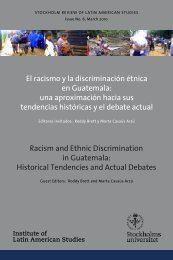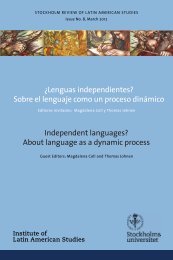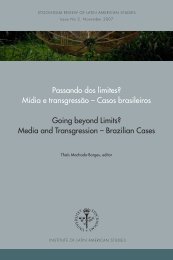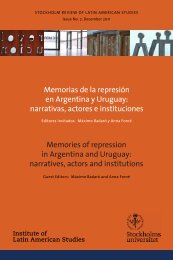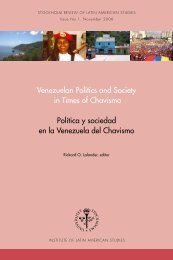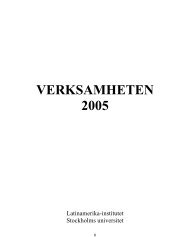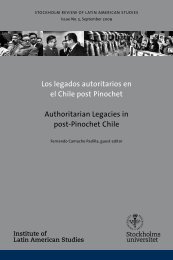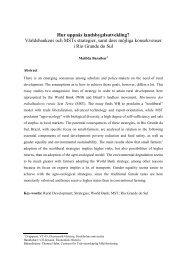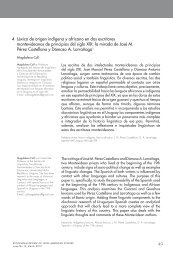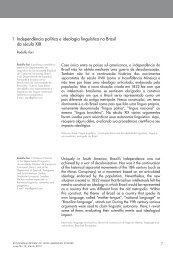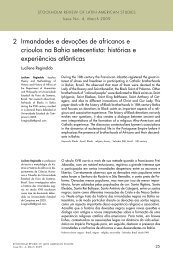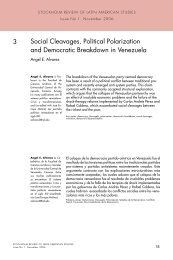Papers - Conference 2009 - Institute of Latin American Studies
Papers - Conference 2009 - Institute of Latin American Studies
Papers - Conference 2009 - Institute of Latin American Studies
Create successful ePaper yourself
Turn your PDF publications into a flip-book with our unique Google optimized e-Paper software.
due to unequal land distribution were violently repressed (MST.org.br; Wolford 2004: 411:Servelo de Medeiros 2007: 1503; Carter 2003: 7). The following 21 years <strong>of</strong> dictatorship wasa turbulent period with industrialization, mechanization <strong>of</strong> the agricultural sector, and whathas been called “the economic miracle” (Wolford 2004: 411; Meszaros 2000: 3; see alsoWelch 2006: 200). Although the economy <strong>of</strong> Brazil grew rapidly, the gains were unequallydistributed. 2 For the ones excluded from the economic progress, reality was experiencedthrough unemployment, mass movements <strong>of</strong> people, and increased urbanization (Perz 2000;Vanden 2003: 326f; Wolford 1996: 457; Plummer & Ranum 2002: 18: Servelo de Medeiros2007: 1503). 3In the early 1980s, due to external debts and inflation, the military government lost powerand gave in 1985 room for a democratic election (Wolford 2004: 411). This was also theperiod in which MST was <strong>of</strong>ficially established (Löwy 2001: 36f; Welch 2006: 200; Carter2003: 8ff; Servolo de Medeiros 2007: 1504; Hammond 1999: 473). MST can be seen as aresponse to longstanding economic, social and political inequalities that have been part <strong>of</strong>Brazilian society since colonial times until present days (Vanden 2003: 326). 4 An importantdriving force for the becoming <strong>of</strong> MST was the Pastoral Land Commision, or CPT(Commissão Pastoral da Terra), that was formed by activists within the Catholic and Lutheranchurches in 1975 (Welch 2006: 202; Löwy 2001). What characterized CPT, and which can beseen within MST still today, was its criticism towards “[…] the drastic social consequences <strong>of</strong>the introduction <strong>of</strong> capitalism in the countryside” (Löwy 2001: 36). CPT also contributed tothe making <strong>of</strong> space and infrastructure for meetings and organizations <strong>of</strong> peasantorganizations. By doing so they brought public attention to the struggles for land. Arguingthat land was “a gift from god” (Karriem 2008: 4) and therefore a right <strong>of</strong> the landless, CPTgave “theological legitimacy” to this struggle (Servolo de Madeiros 2007: 1501). Sincelandownership in Brazil is synonymous to power and wealth, it has got a certain value asstatus symbol (see Servolo de Medeiros 2007: 1502). However, in the Brazilian constitution itis written that “[…] the use <strong>of</strong> property is subordinated to social well-being” (Ibid.). Thismeans that land which is not being used should be expropriated by the state in favor <strong>of</strong> thepeople willing to cultivate it (MSTbrazil.org; Servolo de Medeiros 2007: 1502; Hammond1999: 68). The main strategy applied by the MST to urge the government for expropriation2 In 1960 five percent <strong>of</strong> the population received 27,7 percent <strong>of</strong> the nation‟s total income. In 1990 this numberwas 35,8 percent (Wolford 2004: 421, footnote 5). For more figures, see Meszaros 2000: 3.3 In a period <strong>of</strong> 20 years Brazil went from being a country with about 75 percent <strong>of</strong> its population in rural areasto instead having 75 percent <strong>of</strong> its population in urban areas (Plummer and Ranum 2002: 18).4 In 1996 one percent <strong>of</strong> the landowners owned 45 percent <strong>of</strong> all agricultural land (MST[b] Vanden 2003: 326;Kjörling 2004: 47).2



